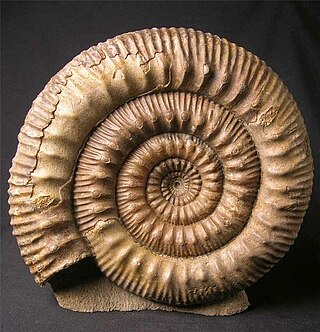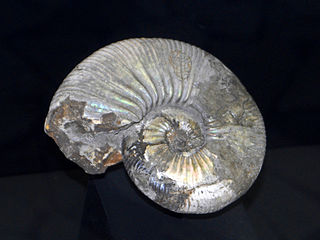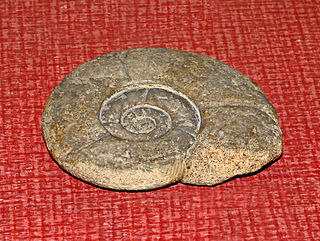
Stephanoceras is an extinct genus of Stephanoceratoid ammonite which lived during the Bajocian. It is the type genus of the family Stephanoceratidae.
Abbasites is an extinct genus of ammonites from the early Middle Jurassic epoch, included in the ammonitid family Erycitidae.

Acanthohoplites is an extinct genus of ammonites in the family Parahoplitidae that lived in the Aptian and Early Albian stages of the Early Cretaceous.

Aspidoceras is an extinct ammonoid cephalopod genus belonging to the family Aspidoceratidae.

Audaxlytoceras is an extinct genus of lytoceratid ammonites.

Arcticoceras is an extinct ammonoid cephalopod genus from the late Middle Jurassic belonging to the ammonite family Cardioceratidae, more commonly found to high northern latitudes.

Berriasella is a discoidal evolute perisphinctacean ammonite, and type genus for the neocomitid subfamily Berriasellinae. Its ribbing is distinct, consisting of both simple and bifurcated ribs that extend from the umbilical seam across the venter; its whorl section generally compressed, the venter more or less narrowly rounded. The species Berriasella jacobi traditionally has been regarded an index fossil defining the base of the Cretaceous, however since 2016 this had been replaced by the first occurrence of Calpionella alpina. Some authors regard B. jacobi as instead belonging to the genus Strambergella.
Euaptetoceras is an evolute hildoceratoid ammonite from the lower Middle Jurassic, included in the family Hammatoceratidae and the subfamility Hammatoceratinae. The genus may be a junior synonym for Eudmetoceras of Buckman, 1920.
Ermoceras is a genus of ammonite belonging to the Thomboceratidae family of the Middle Jurassic found in deposites of central Arabia, Sinai, and Algeria with strong primary and secondary ribs and a single row of lateral tubercles; described as having a deep ventral groove
Oecoptychius is an extinct genus of fossil ammonite cephalopods. The species lived during the Middle Jurassic.

Exiteloceras is an ammonite genus from the Late Cretaceous.

Oxynoticeratidae is a family of true ammonites included in the superfamily Psiloceratoidea.

Kepplerites is a moderately evolute ammonite from the lower Callovian included in the Stephanoceratoidea.
Bochianites is a straight shelled ammonite which lived from the Upper Jurassic, Tithonian, to the Lower Cretaceous, Hauterivian in what is now Europe, Greenland, Africa, North America and Asia. The shell is long, narrow, moderately expanding; smooth or with weak to strong oblique annular ribs. Sutural elements are short and boxy. The umbilical lobe, which lies between the lateral lobe and dorsal lobe, on either side, is about the same size as the lobule dividing the first lateral saddle.

Calliphylloceras is an ammonite belonging to the Phylloceratidae.

Hauericeras is an ammonite genus from the Late Cretaceous that lived from the Coniacian to the late Maastrichtian, from about 90 to 66 mya. Fossils have been found in Europe, Russia, South Africa, Australia, India, Iraq, and in the United States.

Neocomites is a genus of ammonite from the Lower Cretaceous, Berriasian to Hauterivian, and type genus for the Neocomitidae.
Parapopanoceras is a ceratitid ammonite with a small, smooth, very involute and moderately globose shell that lived during the middle Triassic.

Puzosia is a genus of desmoceratid ammonites, and the type genus for the Puzosiinae, which lived during the middle part of the Cretaceous, from early Aptian to Maastrichtian. Sepkoski defines the range from Albian to Santonian. The generic name comes from the Serbian words "Puž" (snail) and "oce/ose" (axis), gaining its name from the shell's snail-like appearance.

Harpoceras is an extinct genus of ammonite belonging to the family Hildoceratidae. These cephalopods existed in the Jurassic period, during the Toarcian age from the Falciferum zone to the Commune subzone of the Bifrons zone. They were fast-moving nektonic carnivores.














